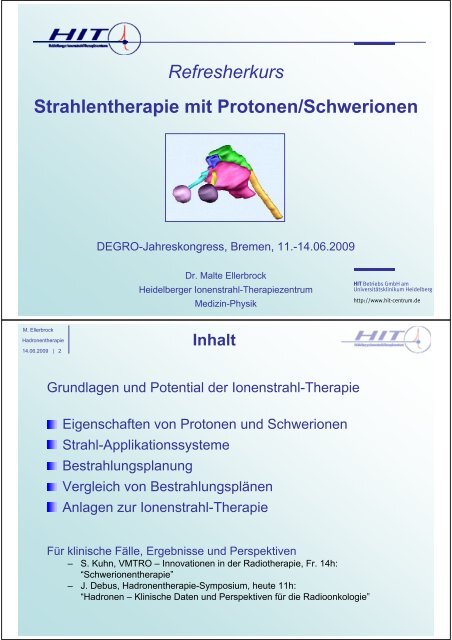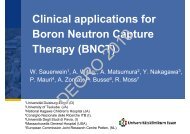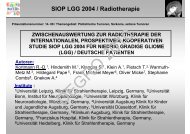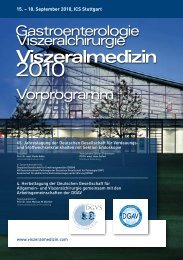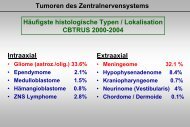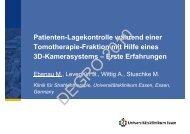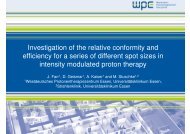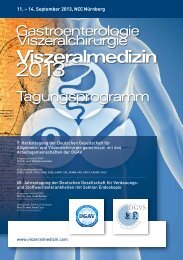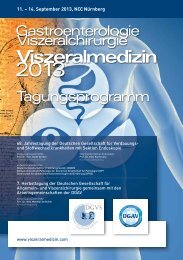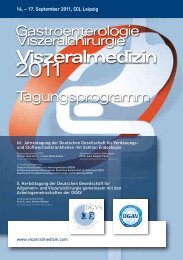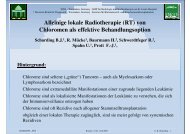Refresherkurs Strahlentherapie mit Protonen ... - Wcenter.de
Refresherkurs Strahlentherapie mit Protonen ... - Wcenter.de
Refresherkurs Strahlentherapie mit Protonen ... - Wcenter.de
Erfolgreiche ePaper selbst erstellen
Machen Sie aus Ihren PDF Publikationen ein blätterbares Flipbook mit unserer einzigartigen Google optimierten e-Paper Software.
<strong>Refresherkurs</strong><br />
<strong>Strahlentherapie</strong> <strong>mit</strong> <strong>Protonen</strong>/Schwerionen<br />
DEGRO-Jahreskongress, Bremen, 11.-14.06.2009<br />
Dr. Malte Ellerbrock<br />
Hei<strong>de</strong>lberger Ionenstrahl-Therapiezentrum<br />
Medizin-Physik<br />
HIT Betriebs GmbH am<br />
Universitätsklinikum Hei<strong>de</strong>lberg<br />
http://www.hit-centrum.<strong>de</strong><br />
M. Ellerbrock<br />
Hadronentherapie<br />
14.06.2009 | 2<br />
Inhalt<br />
Grundlagen und Potential <strong>de</strong>r Ionenstrahl-Therapie<br />
Eigenschaften von <strong>Protonen</strong> und Schwerionen<br />
Strahl-Applikationssysteme<br />
Bestrahlungsplanung<br />
Vergleich von Bestrahlungsplänen<br />
Anlagen zur Ionenstrahl-Therapie<br />
Für klinische Fälle, Ergebnisse und Perspektiven<br />
– S. Kuhn, VMTRO – Innovationen in <strong>de</strong>r Radiotherapie, Fr. 14h:<br />
“Schwerionentherapie”<br />
– J. Debus, Hadronentherapie-Symposium, heute 11h:<br />
“Hadronen – Klinische Daten und Perspektiven für die Radioonkologie”
M. Ellerbrock<br />
Hadronentherapie<br />
14.06.2009 | 3<br />
Inhalt<br />
Eigenschaften von <strong>Protonen</strong> und Schwerionen<br />
Physikalische Eigenschaften<br />
• Tiefendosisverteilung<br />
• laterale Streuung<br />
Biologische Strahlenwirkung<br />
• biologische Effektivität<br />
• Sauerstoffeffekt<br />
• Strahl-Applikationssysteme<br />
• Bestrahlungsplanung<br />
• Vergleich von Bestrahlungsplänen<br />
• Anlagen zur Ionenstrahl-Therapie<br />
M. Ellerbrock<br />
Hadronentherapie<br />
14.06.2009 | 4<br />
Konformale <strong>Strahlentherapie</strong><br />
Wirkung und Nebenwirkung:<br />
Tumorkontrolle vs. Komplikation im Normalgewebe<br />
Bessere Konfor<strong>mit</strong>ät:<br />
Erlaubt die Applikation höherer Dosen (höhere Tumorkontrolle),<br />
ohne die Komplikationen im Normalgewebe zu erhöhen.
M. Ellerbrock<br />
Hadronentherapie<br />
14.06.2009 | 5<br />
<strong>Strahlentherapie</strong> <strong>mit</strong> <strong>Protonen</strong> und Ionen<br />
Tiefendosisverteilung<br />
SOBP<br />
Spread Out<br />
Bragg Peak<br />
Schonung <strong>de</strong>s Gewebes im Eintrittsbereich<br />
Keine / wenig Dosis hinter <strong>de</strong>m Tumorvolumen<br />
Erhöhte biologische Wirksamkeit von 12 C-Ionen im Bragg-Peak<br />
M. Ellerbrock<br />
Hadronentherapie<br />
14.06.2009 | 6<br />
Woher kommt <strong>de</strong>r Bragg-Peak<br />
Energieverlust gela<strong>de</strong>ner Teilchen in Materie<br />
Bethe- (Bloch-) Formel:<br />
Projektil Target F(β) Projektilgeschwindigkeit, β=v/c<br />
D<br />
= −Φ⋅<br />
1<br />
ρ<br />
dE<br />
dx<br />
<strong>Protonen</strong> in Wasser<br />
Φ :<br />
ρ<br />
:<br />
Teilchen - Fluenz<br />
Dichte <strong>de</strong>s Absorbers
M. Ellerbrock<br />
Hadronentherapie<br />
14.06.2009 | 7<br />
Klinische Relevanz <strong>de</strong>r Tiefendosisverteilung<br />
Photons<br />
Protons<br />
Ionen bieten höhere Dosis-Konfor<strong>mit</strong>ät und geringere Integraldosis<br />
M. Ellerbrock<br />
Hadronentherapie<br />
14.06.2009 | 8<br />
Laterale Aufstreuung im Gewebe<br />
(300 MeV/u)<br />
Vielfachstreuung<br />
von Ionen<br />
(E. Rutherford)<br />
(200 MeV)<br />
<strong>de</strong>pth [cm]<br />
Vernachlässigbare Seitenstreuung von 12 C-Ionen im Vergl. zu <strong>Protonen</strong>
M. Ellerbrock<br />
Hadronentherapie<br />
14.06.2009 | 9<br />
Biologische Wirksamkeit<br />
… beruht hauptsächlich auf Doppelstrang-Brüchen <strong>de</strong>r DNA im Zellkern<br />
… ist abhängig vom linearen Energietransfer (LET)<br />
Ionisationsspuren<br />
LET γ-Strahlung<br />
niedriger<br />
LET<br />
1MeV <strong>Protonen</strong><br />
1MeV/u α-Teilchen<br />
1MeV/u 12 C-Ionen<br />
hoher<br />
LET<br />
Der größere Energieverlust von Ionen<br />
erzeugt eine größeren Anzahl von<br />
Sekundärelektronen.<br />
M. Ellerbrock<br />
Hadronentherapie<br />
14.06.2009 | 10<br />
Lokale Dosis<br />
auf μm-Skala<br />
Biologische Wirksamkeit<br />
Strahlenwirkung<br />
im Zellkern<br />
Niedrig-LET<br />
Homogene<br />
Dosisverteilung<br />
Hoch-LET<br />
Hohe lokale Dosis<br />
gleiche makroskopisch<br />
absorbierte Dosis<br />
M. Scholz et al., Rad. Res. 2001,<br />
Immunfloureszenzdarstellung<br />
<strong>de</strong>s Reparaturproteins p21
M. Ellerbrock<br />
Hadronentherapie<br />
14.06.2009 | 11<br />
Das Linear-Quadratische Mo<strong>de</strong>ll<br />
Zell-Überlebenskurven (survival):<br />
S(<br />
D)<br />
= e<br />
−(<br />
α D+βD<br />
2<br />
)<br />
Ein einzelnes Elektron<br />
verursacht einen DSB<br />
Effekt ~ αD<br />
2 Elektronen<br />
verursachen DSB<br />
Effekt ~ βD 2<br />
von Hall, 2002<br />
M. Ellerbrock<br />
Hadronentherapie<br />
14.06.2009 | 12<br />
Definition <strong>de</strong>s RBE<br />
RBE: Relative Biological Effectiveness<br />
Aufgrund <strong>de</strong>r schulterförmigen Photonen-Überlebenskurve:<br />
Der RBE ist abhängig von: <strong>de</strong>r Dosis!<br />
<strong>de</strong>m biol. Endpunkt
M. Ellerbrock<br />
Hadronentherapie<br />
14.06.2009 | 13<br />
RBE-Abhängigkeit vom Gewebe<br />
Tumor<br />
resistent<br />
Tumor<br />
sensitiv<br />
Normalgewebe<br />
resistent<br />
Normalgewebe<br />
sensitiv<br />
Schwerionen sind nicht immer besser…<br />
[M. Scholz, GSI]<br />
M. Ellerbrock<br />
Hadronentherapie<br />
14.06.2009 | 14<br />
RBE-Abhängigkeit<br />
Klinischer RBE:<br />
<strong>Protonen</strong><br />
RBE = 1.1<br />
12<br />
C-Ionen<br />
RBE = 2-4<br />
Der RBE hängt ab von:<br />
LET<br />
Fraktions-Dosis<br />
Biologischer Endpunkt<br />
Bestrahltes Gewebe
M. Ellerbrock<br />
Hadronentherapie<br />
14.06.2009 | 15<br />
Sauerstoff-Effekt<br />
Die Sauerstoff-Konzentration hat Einfluss auf die Strahlenwirkung.<br />
Die Größe <strong>de</strong>s Effektes ist abhängig vom LET.<br />
Sauerstoffeffekt (oxygen enhancement ratio):<br />
OER = D ohne O2 /D <strong>mit</strong> O2<br />
| gleiche Wirkung<br />
M. Ellerbrock<br />
Hadronentherapie<br />
14.06.2009 | 16<br />
Radiation Interactions – Oxygen Effect<br />
Radiation interactions<br />
primarily with water<br />
Indirect radiation damage<br />
Dominant radiation action for<br />
low LET radiation<br />
Direct radiation damage<br />
Dominant radiation action for<br />
high LET radiation
M. Ellerbrock<br />
Hadronentherapie<br />
14.06.2009 | 17<br />
Sauerstoffeffekt als Funktion <strong>de</strong>s LET<br />
OER nimmt <strong>mit</strong> LET<br />
stark ab<br />
~kein Sauerstoffeffekt<br />
für 12 C-Ionen<br />
besseres Ansprechen<br />
schlecht versorgter,<br />
hypoxischer<br />
Tumorbereiche auf<br />
Hoch-LET-Strahlung<br />
(Zell-Experimente)<br />
Die klinische Relevanz<br />
bleibt zu zeigen!<br />
M. Ellerbrock<br />
Hadronentherapie<br />
14.06.2009 | 18<br />
Fragmentation von 12 C-Ionen<br />
Projektil<br />
Patient<br />
Projektil<br />
Fragmente<br />
1<br />
12<br />
C<br />
Target<br />
2<br />
3<br />
n
M. Ellerbrock<br />
Hadronentherapie<br />
14.06.2009 | 19<br />
Aktivierung <strong>de</strong>s Gewebes durch 12 C-Ionen<br />
PET<br />
n<br />
γ<br />
γ<br />
PET<br />
In Vivo Monitoring <strong>de</strong>r Bestrahlung<br />
M. Ellerbrock<br />
Hadronentherapie<br />
14.06.2009 | 20<br />
PET-Monitoring in vivo<br />
12<br />
C-Therapie für Patient <strong>mit</strong> Schä<strong>de</strong>lbasis-Chondrosarcom<br />
Dosis-Verteilung<br />
PET-Messung<br />
‣ Vorhersage <strong>de</strong>r PET-Aktivität <strong>mit</strong> TPS<br />
‣ Vergleich <strong>de</strong>r Messung <strong>mit</strong> <strong>de</strong>r Berechnung<br />
Unabhängige Verifikation <strong>de</strong>r Strahl-Applikation!
M. Ellerbrock<br />
Hadronentherapie<br />
14.06.2009 | 21<br />
Zusammenfassung (1):<br />
Vorteile von Hadronen in <strong>de</strong>r <strong>Strahlentherapie</strong><br />
Physikalische Selektivität<br />
<strong>Protonen</strong> & Schwerionen<br />
Tiefendosisverlauf (Bragg-Peak)<br />
Reduzierung <strong>de</strong>r Integraldosis<br />
Aktive Feldformung (Scanning)<br />
Schwerionen<br />
Weniger laterale Streuung<br />
In vivo Monitoring durch PET<br />
Biologische Effektivität<br />
Schwerionen<br />
Hohe lokale Effektitivät (hoch-LET)<br />
Höherer RBE im Bragg-Peak-Bereich<br />
Nur kleiner Sauerstoffeffekt<br />
M. Ellerbrock<br />
Hadronentherapie<br />
14.06.2009 | 22<br />
Das Potential von Hadronen<br />
in <strong>de</strong>r <strong>Strahlentherapie</strong><br />
Vergleich von <strong>Protonen</strong>, Neutronen, Pionen und schweren Ionen <strong>mit</strong> Photonen<br />
n<br />
konv.<br />
Ar<br />
Si<br />
Ne<br />
Pionen<br />
C-12<br />
Biologische<br />
Wirksamkeit<br />
Co-60<br />
X-rays<br />
10MV.<br />
X-rays<br />
IMRT<br />
P<br />
konv.<br />
P<br />
IMRT<br />
Dosiskonfor<strong>mit</strong>ät
M. Ellerbrock<br />
Hadronentherapie<br />
14.06.2009 | 23<br />
Inhalt<br />
• Eigenschaften von <strong>Protonen</strong> und Schwerionen<br />
Strahl-Applikationssysteme<br />
Passive Feldformung<br />
• Breites Ionenstrahlfeld + Kollimierung + Kompensation<br />
Aktives Scannen<br />
• Schmaler Ionenstrahl + Spot-/Rasterscanning<br />
• Bestrahlungsplanung<br />
• Vergleich von Bestrahlungsplänen<br />
• Anlagen zur Ionenstrahl-Therapie<br />
M. Ellerbrock<br />
Hadronentherapie<br />
14.06.2009 | 24<br />
Passive beam shaping (standard method!)<br />
A) Lateral spreading of the beam<br />
Methods:<br />
• Double scattering<br />
• Beam wobbling<br />
• Bimetal scatterers
M. Ellerbrock<br />
Hadronentherapie<br />
14.06.2009 | 25<br />
Passive field shaping<br />
B) Shaping of the <strong>de</strong>pth dose (SOBP)<br />
Modulation wheel<br />
Modulator <strong>de</strong>sign and SOBP<br />
Biol. eff. dose<br />
Physical dose<br />
RBE <strong>de</strong>pen<strong>de</strong>nces: Modulator for fixed tissue, fraction dose, endpoint, etc.<br />
Delivery of only 1 field/day (RBE dose <strong>de</strong>pen<strong>de</strong>nce!)<br />
M. Ellerbrock<br />
Hadronentherapie<br />
14.06.2009 | 26<br />
Passive field shaping<br />
C) Patient specific hardware for beam shaping<br />
Range shifter for<br />
range adaption<br />
Collimator for<br />
lateral field shaping<br />
Compensator for<br />
tissue inhomogeneities
M. Ellerbrock<br />
Hadronentherapie<br />
14.06.2009 | 27<br />
Compensators for field shaping<br />
Shaping the distal end of the target volume<br />
Beam<br />
High dose region<br />
SOBP has fixed extension<br />
Dose conformation at distal edge only<br />
High skin dose, esp. at field edges<br />
M. Ellerbrock<br />
Hadronentherapie<br />
14.06.2009 | 28<br />
Advantages of active beam shaping<br />
<br />
Fixed <strong>de</strong>pth modulation<br />
Fixed lateral collimation<br />
Dose conformation<br />
only at distal end<br />
<br />
Variable <strong>de</strong>pth modulation<br />
Collimation of sub fields<br />
Dose conformation<br />
also at proximal edge
M. Ellerbrock<br />
Hadronentherapie<br />
14.06.2009 | 29<br />
Active beam shaping: 3D beam scanning (GSI)<br />
Irradiation of raster points with pencil beam: ~3 mm SOBP, ~5 mm FWHM<br />
• Depth: Active beam energy variation of synchrotron (~3 mm steps)<br />
• Lateral: Intensity controlled raster scanning (~2 mm step size)<br />
Typically 30-50 energy slices, in total 20000-50000 raster points<br />
M. Ellerbrock<br />
Hadronentherapie<br />
14.06.2009 | 30<br />
Intensity controlled Raster Scanning<br />
Accelerator and<br />
beam line<br />
active variation<br />
of the beam<br />
energy, focus<br />
and intensity<br />
Fast dipole magnets<br />
scanning of<br />
focussed<br />
ion beams<br />
Online monitoring<br />
system<br />
active position<br />
and intensity<br />
feed back loops<br />
Raster scanning: Continuous beam-on<br />
Spot scanning:<br />
Beam is switched off between raster points
M. Ellerbrock<br />
Hadronentherapie<br />
14.06.2009 | 31<br />
Consequences of active beam shaping<br />
Advantages<br />
Better dose conformation than with passive techniques<br />
(→ Dose conformation at the distal and proximal edge of the tumor)<br />
More flexible, since no patient specific hardware is nee<strong>de</strong>d<br />
Generation of aribitrary-shaped dose distributions<br />
(→ Intensity modulated particle radiotherapy, IMPT)<br />
Special requirements<br />
High <strong>de</strong>mand to beam <strong>de</strong>livery and control system<br />
Energy <strong>de</strong>pen<strong>de</strong>nt calibration of the radiation monitor<br />
Dose verification at one point not sufficient<br />
RBE calculation at each point of the radiation field<br />
M. Ellerbrock<br />
Hadronentherapie<br />
14.06.2009 | 32<br />
Inhalt<br />
• Eigenschaften von <strong>Protonen</strong> und Schwerionen<br />
• Strahl-Applikationssysteme<br />
Bestrahlungsplanung<br />
Reichweite<br />
Biologisch effektive Dosisoptimierung<br />
• Vergleich von Bestrahlungsplänen<br />
• Anlagen zur Ionenstrahl-Therapie
M. Ellerbrock<br />
Hadronentherapie<br />
14.06.2009 | 33<br />
Reichweiteberechnung für <strong>Protonen</strong> / Ionen<br />
Empirische Korrelation zwischen Reichweite und CT-Zahl<br />
Range relative to water<br />
Vorraussetzungen:<br />
‣ Qualitätssicherung <strong>de</strong>s CT<br />
‣ Bildgebungsprotokoll<br />
(kV, pixel size, pitch, reco, ...)<br />
Phantom <strong>mit</strong> Gewebeproben<br />
CT number<br />
M. Ellerbrock<br />
Hadronentherapie<br />
14.06.2009 | 34<br />
Reichweite-Unsicherheiten<br />
Anatomische Än<strong>de</strong>rungen während Therapie (Abnahme, Erkältung)<br />
Positionierungsunsicherheiten (scharfer Bragg-Peak)<br />
Bildartefakte<br />
Fehlpositionierung<br />
Metallartefakte<br />
Erfor<strong>de</strong>rt präzise Positionierung <strong>de</strong>s Patienten, ggf. Robustheitsanalyse.<br />
Vermeidung von Fel<strong>de</strong>rn, bei <strong>de</strong>nen <strong>de</strong>r Strahl direkt vor einem OAR stoppt.
M. Ellerbrock<br />
Hadronentherapie<br />
14.06.2009 | 35<br />
Treatment planning for heavy ions<br />
For passive beam <strong>de</strong>livery systems:<br />
Modulation wheel is <strong>de</strong>signed to yield homog. biol. eff. <strong>de</strong>pth dose<br />
1. Depth and extension of the tumor <strong>de</strong>termines<br />
• range modulation (modulator wheel)<br />
• bolus thickness (range shifter)<br />
2. Depth dose curve is <strong>de</strong>termined by<br />
• the combination of modulator wheel and range shifter<br />
3. Calibration for each combination in the middle of the SOBP (TRS-398)<br />
• Calibration factor: Dose/MU<br />
No <strong>de</strong>tailed biological mo<strong>de</strong>ling nee<strong>de</strong>d!<br />
M. Ellerbrock<br />
Hadronentherapie<br />
14.06.2009 | 36<br />
Biological effective dose optimization for<br />
heavy ions with active beam <strong>de</strong>livery<br />
Physical dose optimization<br />
Biological dose optimization<br />
Dose in Gy<br />
12<br />
C<br />
Dose in Gy<br />
12<br />
C<br />
<strong>de</strong>pth in mm<br />
<strong>de</strong>pth in mm<br />
The <strong>de</strong>pth modulation varies for every point in the field!<br />
Account for nuclear fragmentation in every point in 3D<br />
Detailed biological mo<strong>de</strong>ling necessary<br />
Optimization of absolute value of dose and particle numbers
M. Ellerbrock<br />
Hadronentherapie<br />
14.06.2009 | 37<br />
Principles of the Local Effect Mo<strong>de</strong>l (LEM)<br />
Input parameters:<br />
‣ Particle spectrum<br />
‣ Radial Dose distribution<br />
1<br />
c<br />
D(<br />
r)<br />
∝ r ∝ E<br />
max<br />
r<br />
2<br />
‣ Photon dose response<br />
− ( α D + βD<br />
2<br />
)<br />
S(<br />
D)<br />
= e<br />
‣ Target size: cell nucleus<br />
Scholz and Kraft, Adv. Space Res. 1996<br />
Scholz et al., Rad. Env. Biophys. 1997<br />
M. Ellerbrock<br />
Hadronentherapie<br />
14.06.2009 | 38<br />
Therapieplanung: biologische Optimierung<br />
Physikalische Dosis<br />
<strong>de</strong>r Einzelfel<strong>de</strong>r<br />
12<br />
C<br />
Biologisch effektive Dosis<br />
RBE-Verteilung<br />
3.8 3.5<br />
2.9<br />
Berechnung <strong>de</strong>s RBE an je<strong>de</strong>m Punkt!
M. Ellerbrock<br />
Hadronentherapie<br />
14.06.2009 | 39<br />
Scanspot Distribution<br />
E min<br />
23 energy slices<br />
graphical area 6x6 cm 2<br />
pixel size ∝ part. number<br />
Highest fluence at the distal<br />
end of each spot position,<br />
cf.<br />
E max<br />
Already fluence modul. RT<br />
(ion IMRT), although homog.<br />
dose of individual fields<br />
1-3 fields sufficient, since<br />
many <strong>de</strong>grees of freedom<br />
M. Ellerbrock<br />
über chromosomen<br />
16/06/2009 | 40<br />
IMPT: Multiple field dose optimization<br />
… to further increase dose confor<strong>mit</strong>y and improve sparing of OARs<br />
separate optimization<br />
Single field opt.<br />
field 1<br />
field 2<br />
final sum<br />
simultaneous optimization<br />
Multiple field opt.
M. Ellerbrock<br />
Hadronentherapie<br />
14.06.2009 | 41<br />
Inhalt<br />
• Eigenschaften von <strong>Protonen</strong> und Schwerionen<br />
• Strahl-Applikationssysteme<br />
• Bestrahlungsplanung<br />
Vergleich von Bestrahlungsplänen<br />
Vergleich von 12 C, <strong>Protonen</strong>, Photonen<br />
GSI-Erfahrung<br />
• Anlagen zur Ionenstrahl-Therapie<br />
M. Ellerbrock<br />
Hadronentherapie<br />
14.06.2009 | 42<br />
Proton IMRT vs. Photon IMRT<br />
Same field configuration, 5 fields each<br />
Proton IMRT<br />
Photon IMRT<br />
Protons: Reduction of integral dose and lower doses to OARs
M. Ellerbrock<br />
Hadronentherapie<br />
14.06.2009 | 43<br />
12<br />
C ions vs. Photon IMRT (I)<br />
12<br />
C ions (2 fields) Photon IMRT (9 fields)<br />
12<br />
C ions: Better sparing of OAR and reduction of integral dose<br />
M. Ellerbrock<br />
Hadronentherapie<br />
14.06.2009 | 44<br />
12<br />
C ions vs. Photon IMRT (II)<br />
12<br />
C ions (3 fields) | Photon IMRT (9 fields)<br />
12<br />
C ions: Better dose confor<strong>mit</strong>y<br />
Steeper dose gradients, better sparing of OARs<br />
Lower integral dose<br />
Higher biological efficiency
M. Ellerbrock<br />
Hadronentherapie<br />
14.06.2009 | 45<br />
12<br />
C ions vs. Protons<br />
Carbon ions (GSI)<br />
Protons (Data: Kapstadt/SA)<br />
12C ions:<br />
Advantages from beam scanning and smaller lateral scattering<br />
M. Ellerbrock<br />
Hadronentherapie<br />
14.06.2009 | 46<br />
GSI: 12 C-Therapie für Schä<strong>de</strong>lbasis<br />
Chordome und Chondrosarkome<br />
Ionentherapie als primäre <strong>Strahlentherapie</strong>:<br />
20 Fraktionen a 3.0-3.5 GyE (7Fx/Woche)
M. Ellerbrock<br />
Hadronentherapie<br />
14.06.2009 | 47<br />
GSI: Klinische Studie I: Schä<strong>de</strong>lbasis<br />
Chordome / Chondrosarkome<br />
C-12 RT<br />
Teilchen RT<br />
Konventionelle<br />
Photonen RT<br />
[Schulz-Ertner et al., IJROBP 2006]<br />
M. Ellerbrock<br />
Hadronentherapie<br />
14.06.2009 | 48<br />
GSI: Kombinations-Therapie für ACCs<br />
Photonen-IMRT<br />
54 Gy auf PTV<br />
Boost-Bestrahlung<br />
<strong>mit</strong> 12 C-Ionen<br />
18 GyE auf GTV
M. Ellerbrock<br />
Hadronentherapie<br />
14.06.2009 | 49<br />
GSI: Klinische Studie II: ACCs<br />
Lokale<br />
Tumor-<br />
Kontrolle<br />
IMRT + C12<br />
IMRT<br />
[Schulz-Ertner et al., Cancer 2004]<br />
M. Ellerbrock<br />
Hadronentherapie<br />
14.06.2009 | 50<br />
Inhalt<br />
• Eigenschaften von <strong>Protonen</strong> und Schwerionen<br />
• Strahl-Applikationssysteme<br />
• Bestrahlungsplanung<br />
• Vergleich von Bestrahlungsplänen<br />
Anlagen zur Ionenstrahl-Therapie<br />
<strong>Protonen</strong><br />
Schwerionen
M. Ellerbrock<br />
Hadronentherapie<br />
14.06.2009 | 51<br />
Proton therapy<br />
M. Ellerbrock<br />
Hadronentherapie<br />
14.06.2009 | 52<br />
Patients treated with protons and ions 12/2008<br />
Facilities in operation:<br />
Total pat. numbers<br />
for all facilities<br />
(in op. + out of op.)<br />
Protons: 61122<br />
C ions: 5342<br />
Total: 66464<br />
http://ptcog.web.psi.ch
M. Ellerbrock<br />
Hadronentherapie<br />
14.06.2009 | 53<br />
Loma Linda Univ. Medical Center (CA, USA)<br />
Weltweite erstes klinisches<br />
<strong>Protonen</strong>-Therapiezentrum<br />
(1990)<br />
M. Ellerbrock<br />
Hadronentherapie<br />
14.06.2009 | 54<br />
<strong>Protonen</strong>gantry<br />
<strong>de</strong>s LLUMC
M. Ellerbrock<br />
Hadronentherapie<br />
14.06.2009 | 55<br />
<strong>Protonen</strong>gantry am Paul Scherrer Institut<br />
Gewicht: 110t<br />
Durchmesser: ca. 4m<br />
Länge: ca. 10m<br />
Genauigkeit: < 1mm<br />
M. Ellerbrock<br />
Hadronentherapie<br />
14.06.2009 | 56<br />
Klin. <strong>Protonen</strong>-Therapiezentren (>500 pts/year)<br />
Laufend o<strong>de</strong>r finanziert:<br />
USA: 7<br />
Japan: 4+4<br />
China: 2<br />
Schweiz: 1<br />
Deutschl.: 2+2<br />
Korea: 1<br />
Italien: 1+1<br />
Österreich: 1<br />
Schwe<strong>de</strong>n: 1<br />
Frankreich: 1<br />
Σ weltweit: 28<br />
Sechs kommerzielle Anbieter:<br />
Optivus, IBA, Mitsubishi, Hitachi, Varian, Siemens
M. Ellerbrock<br />
Hadronentherapie<br />
14.06.2009 | 57<br />
Ion beam therapy in the world in 2008<br />
LLBL (Berkeley, USA): Research facility<br />
1957 – 1992: He, Ne, Si, Ar (in total 2482 patients)<br />
Heavy Ion Medical Accelerator (HIMAC), Chiba, Japan<br />
1994 – today: Carbon ions (~4500 patients)<br />
Gesellschaft für Schwerionenforschung, Germany<br />
1997 – 2008: Carbon ions (437 patients)<br />
Hyogo Ion Beam Medical Center (HIBMC), Hyogo, Japan<br />
2002 – today: protons, Carbon ions (~500 patients)<br />
Hospital facilities un<strong>de</strong>r construction<br />
Hei<strong>de</strong>lberg – HIT (p, He, C, O, …) operational in 2009<br />
Pavia – CNAO (p, C) ready in 2009<br />
Gunma University and Tokyo Hospital, Japan (C) ready in 2009<br />
Rhön Hospital, University Marburg (p, C) ready in 2010<br />
Kiel university Hospital - NROCK (p, C) ready in 2012<br />
MedAustron (Wiener Neustadt), Austria (p, C) ready in 2013<br />
Projects, partially fun<strong>de</strong>d:<br />
Lyon, Caen (F); Berlin, Hamburg (D); Maastricht (NL); Karolinska (S),<br />
Copenhagen (DK), San Francisco (US), …<br />
M. Ellerbrock<br />
Hadronentherapie<br />
14.06.2009 | 58<br />
Ion therapy in Berkeley (1954-1992)<br />
1954 - 1992: 2054 patients (He)<br />
1975 - 1992: 433 patients (Ne, N, O, C, Si, Ar)
M. Ellerbrock<br />
Hadronentherapie<br />
14.06.2009 | 59<br />
Ionentherapie am HIMAC in Chiba / Japan<br />
Therapiebetrieb seit 1994, HIBMC in Hyogo / Japan seit 2002<br />
weltweit einzige klinische Einrichtungen für Schwerionen-<strong>Strahlentherapie</strong><br />
zusammen ~5000 Patienten 12 C<br />
M. Ellerbrock<br />
Hadronentherapie<br />
14.06.2009 | 60<br />
Heavy Ion Medical Acc.<br />
in Chiba, Japan
M. Ellerbrock<br />
Hadronentherapie<br />
14.06.2009 | 61<br />
Layout Hyogo facility for protons and ions<br />
Carbon ion<br />
beam lines<br />
Proton<br />
gantries<br />
Synchrotron for<br />
Proton and ions<br />
M. Ellerbrock<br />
Hadronentherapie<br />
14.06.2009 | 62<br />
Pilot Project at GSI: 12 C Beam Scanning<br />
GSI: Gesellschaft für Schwerionenforschung, Darmstadt<br />
Beam line<br />
Basic research facility<br />
Fixed beam line<br />
• Carbon ion radiation therapy 1997-2008<br />
• 3 treatment periods of 4 weeks per year<br />
• In total 437 patients treated
M. Ellerbrock<br />
Hadronentherapie<br />
14.06.2009 | 63<br />
Hei<strong>de</strong>lberg Ion-Beam Therapy Center<br />
On campus of Hei<strong>de</strong>lberg University<br />
Clinical integration in Dept. of Radiation Oncology<br />
M. Ellerbrock<br />
Hadronentherapie<br />
14.06.2009 | 64<br />
HIT – Cross Section<br />
• compact <strong>de</strong>sign, reliable techn.<br />
• 2 ion sources: p,He,..,C,..,O<br />
selection within minutes<br />
• heavy ion synchrotron<br />
• 3 treatment rooms<br />
- 2 horizontal, fixed beam<br />
- 1 isocentric ion gantry<br />
• 1 QA/exp. cave
M. Ellerbrock<br />
Hadronentherapie<br />
14.06.2009 | 65<br />
HIT – Robotic Patient Positioning System<br />
Fixed horizontal beam<br />
Robotic imaging (30Hz)<br />
Cone beam CT optional<br />
Automated position correction<br />
Isocentric Rotation +/-100°<br />
Step On Position 650 mm<br />
M. Ellerbrock<br />
Hadronentherapie<br />
14.06.2009 | 66<br />
HIT – The Heavy Ion Gantry<br />
world-wi<strong>de</strong> first<br />
heavy ion gantry<br />
integration of<br />
beam scanning<br />
13 m diameter<br />
25 m length<br />
600 tons rotating weight<br />
0.5 mm max. <strong>de</strong>formation<br />
360° rotation in 2 minutes<br />
Treatment room<br />
MT Mechatronics
M. Ellerbrock<br />
Hadronentherapie<br />
14.06.2009 | 67<br />
HIT – Milestones and Status<br />
Building ready for hi-tech installations 10 / 2005<br />
Synchrotron 1st turn 02 / 2007<br />
Horizontal caves: beam commissioned 03 / 2008<br />
preclinical operation 01 / 2009<br />
clinical operation Fall 2009<br />
currently: system integration tests<br />
Gantry: 1st beam @ isocenter 01 / 2008<br />
patient-ready 2010<br />
TPS: commissioned & released 12 / 2008<br />
M. Ellerbrock<br />
Hadronentherapie<br />
14.06.2009 | 68<br />
Zusammenfassung<br />
Eigenschaften von <strong>Protonen</strong> und Schwerionen<br />
Hohe physikalische Selektivität<br />
Erhöhte biologische Effektivität im Bragg-Peak für Schwerionen<br />
Strahl-Applikationssysteme<br />
Aktive Feldformung: flexibler, liefert höhere 3D-Dosiskonfor<strong>mit</strong>ät<br />
erlaubt Ionen-IMPT<br />
Bestrahlungsplanung<br />
Biologische Mo<strong>de</strong>llierung notwendig für Schwerionen (RBE)<br />
Vergleich von Bestrahlungsplänen<br />
Vielversprechen<strong>de</strong> Pläne für <strong>Protonen</strong> und Schwerionen<br />
… und erste klinische Ergebnisse<br />
Anlagen zur Ionenstrahl-Therapie<br />
<strong>Protonen</strong>- und kombinierte <strong>Protonen</strong>-/Schwerionen-Anlagen<br />
Groß, teuer, faszinierend…
M. Ellerbrock<br />
Hadronentherapie<br />
14.06.2009 | 69<br />
Die Zukunft <strong>de</strong>r<br />
<strong>Protonen</strong>- und Ionenstrahl-Therapie<br />
Number Patientenzahl<br />
of patients<br />
70000<br />
60000<br />
50000<br />
40000<br />
30000<br />
20000<br />
10000<br />
0<br />
1955 1960 1965 1970 1975 1980 1985 1990 1995 2000 2005<br />
Time<br />
Zeit<br />
Protons Ions thereof Carbon Ions<br />
<strong>Protonen</strong><br />
Ionen<br />
davon 12 C<br />
Data from<br />
http://ptcog.web.psi.ch<br />
<strong>Protonen</strong>: Etabliert in <strong>de</strong>r klinischen Routine<br />
Schwerionen: Startklar für breitere klinische Anwendung<br />
Klinische Studien zur Klärung <strong>de</strong>r Rolle <strong>de</strong>r Ionenstrahl-Therapie<br />
in <strong>de</strong>r Strahlenonkologie: Indikationen Ionensorten …<br />
M. Ellerbrock<br />
Hadronentherapie<br />
14.06.2009 | 70<br />
Thank you for your attention<br />
PTCOG 48: September 28th – October 3rd, 2009


